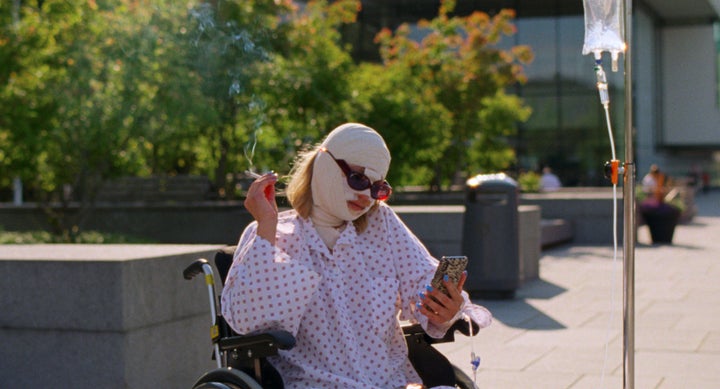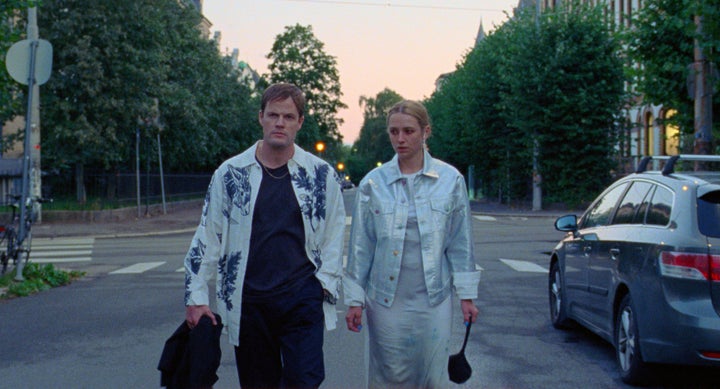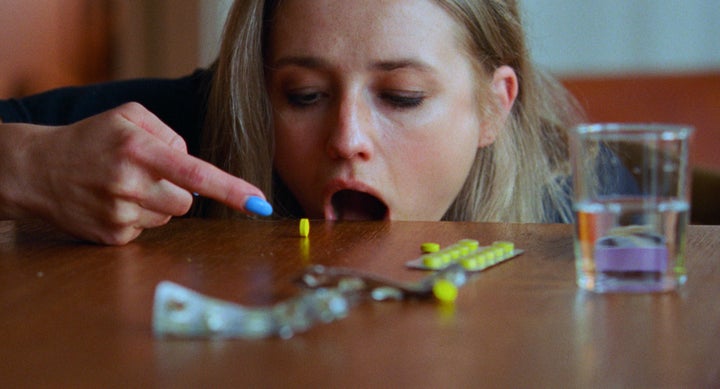
This article discusses plot details from “Sick of Myself.”
If you’re reading this, it means you’ve probably already consumed your daily dose of unreality and self-important posts on social media that scream: Look at ME! Look at what I’m doing! Aren’t I great? Isn’t this cool?
It’s enough to make you — I don’t know — maybe want to create an alternate script about the world around you, where you are the one getting all the attention.
And, when the situation calls for it, all the sympathy.
That’s the cynical space in which the pitch-dark new comedy “Sick of Myself” sits. Writer-director Kristoffer Borgli bends the rules of satire, body horror and realism to present a rewardingly textured story steeped in our modern malaise.
It centers on Signe (Kristine Kujath Thorp), a young barista in Oslo, Norway, who spends a lot of her day blankly perusing her friends’ online accounts and staring at the faces of coffee shop customers.
Afterward, she comes home to the apartment she shares with her boyfriend Thomas (Eirik Sæther), an “artist” who steals furniture to use both in their hollow residence and in his art shows (often presented in ways that look just pretentious enough to appeal to pompous aesthetes).
Signe’s thinly veiled exasperation makes for acerbically hilarious scenes like when the couple meet up with Thomas’ friends at a bougie cafe where they gush over his next showing at a prestigious gallery. Or rather, as Signe reminds the table, it’s not exactly at that gallery, but outside in a space down the street from it — not to be confused with a premier event.
What’s so cunning about “Sick of Myself” is that it reflects how naturally jealousy can manifest, even among those we’re closest with, in a world where people’s self-worth is dangerously tethered to external validation. Borgli himself is no stranger to this state of mind.
“Even I can have this feeling,” the filmmaker admitted to HuffPost. “A friend of mine who I love and actually support — if that person suddenly gets really successful, it’s like a little piece of me dies.”
These kinds of uncomfortable, socially forbidden truths are what Borgli was wrestling with when he came up with the idea for “Sick of Myself.”
“I have this feeling that just is triggered that I don’t want to listen to and I don’t want to act on it,” he said. “But it does feel painful for whatever reason, and I think that pain is what I wanted to make into a cinematic experience.”
Right away, this concept brings to mind last year’s ill-conceived Hulu movie “Not Okay,” which failed to grapple with any of the complexities of narcissism and social endorsement in our contemporary landscape.
But “Sick of Myself,” which grows more and more bizarre as it goes on, is more like the “Black Mirror” episode “Nosedive,” in that the audience is immersed in an intensely layered, reality-adjacent world, one where some of our most objectionable norms are mirrored on screen.
And more than that, they’re presented in a way that is uneasy to watch ― even though the film is, refreshingly, not beholden to an obvious moral standpoint.

For Borgli, to judge the events in “Sick of Myself” — especially Signe’s inner thoughts, which get more grotesque as the film progresses — would be to chide the world around him, including some of his own behavior, without attempting to understand any of it.
Instead, he wanted to examine it on screen. “Most people have a filter and stop themselves on acting upon such negative emotions,” Borgli said.
Signe completely detaches herself from that responsibility. “I wanted this cathartic experience of seeing someone who just goes all the way there and doesn’t have a single brake or a single filter to stop them,” Borgli said, “and feel this pressure valve opened by just vetting it or letting it live in fiction, so that it doesn’t have to exist in my life.”
Borgli explored media manipulation with his first feature, “Drib,” in 2017. But since our codependent relationship with media is such a deep-seated reality, he continues to return to it.
“I think it’s just become what water is to a fish, almost,” he said. “You can’t escape it. It would be weird to talk about modern life without having that be an element in it.”
The idea for “Sick of Myself” came to Borgli when he moved to Los Angeles from his native Norway, and started encountering people like Signe, who were desperate to do anything just to seem interesting. The character goes so far as to disfigure herself, risking her health.
“There was this idea brewing in the back of my head, and I had this image in my head of a blonde girl in Oslo with a horrific skin disease,” Borgli explained.
“But she was smiling,” he went on. “I didn’t know, really, what the story was going to be. But I wrote it in L.A. and I was living here, bumping up against people here and the culture here, and I think that actually influenced how this character became.”
And part of that, as Borgli concluded, is “more of an L.A. person, almost.”
With “Sick of Myself,” he wanted to examine the various elements that play a role in that mindset. “I’m looking at the personal psychology of competitiveness and narcissism and career ambitions and identity,” he said, “and wanting to have a story to tell, and how that pressure, of course, can be amplified when everyone has a platform.”
A film like this, though, immediately brings up questions of privilege — and it’s up to the storyteller to be able to address them.

Norway is far more culturally homogenous than Los Angeles, and Borgli calls it less career- and identity-focused as well. Signe is a young, able-bodied white woman who doesn’t really have a story. So she tries to benefit from the type of mass acknowledgment that marginalized people sometimes gain ― which says a lot about who she is.
She seems to be aware that she has “a bad personality,” as revealed in one of the film’s dark fantasy sequences where she receives the rattling diagnosis after a CT scan.
“I think for Signe in ‘Sick of Myself,’ being a blonde, privileged, upper-middle-class girl in Oslo who works at a coffee shop — it’s like she’s not really part of any conversation,” Borgli said. “She doesn’t have a voice in anything, and I think she really wants validation and attention, and I think she just subconsciously gets drawn to the kind of attention that victims get.”
Signe renders herself unrecognizable on her way to gaining a fleeting amount of social and professional acclaim. Through an internet search, she is able to find a pill that causes an aggressive skin disease as a side effect. She gets her hands on a batch, and her face and the rest of her body effectively disfigure, until she is nearly covered in rashes and blisters.
The prosthetics in “Sick of Myself” are, unsurprisingly, inspired by a master of body horror whose work Borgli became fond of when he was a teenager working in a video store.
“One of the elements that I really liked was David Cronenberg and body horror visually,” Borgli recalled, referring to the director of such similarly unnerving films as “The Brood” and “Scanners.”
With “Sick of Myself,” Borgli takes those influences and turns them into something uniquely his own.
“I don’t think I could articulate it then, but it has dawned on me that I really like the visual landscape of prosthetics and dysmorphia and all of those elements that exist in body horror,” he said. “But not necessarily loving the tone of those movies.”
With those sorts of movies, Borgli explained, you go into them expecting the horror to happen. “So it’s not really surprising,” he said. “I have had this really long dream of making a movie where the body horror element started showing up in a normal setting in a movie where you weren’t expecting.”
Enter “Sick of Myself,” a film you might go into with few expectations, only to get a whole variety of elements — including humor, romantic dysfunction, horror and social commentary.
For a moment, Signe acquires the attention she’s long craved, both from Thomas and from people in general. But that also has side effects that include loss of hair, an addiction and a prison of her own making.
That said, the “bad personality” in “Sick of Myself” does come with a consequence.
Borgli, for his part, doesn’t agree that Signe becomes addicted to the drug, even though she ingests perilous amounts of it. Rather, he feels like she’s addicted to what it gives her. That’s another real-life cue from which he took elements for the film.
There’s a long history of fictional drugs in films — “The Matrix,” “A Clockwork Orange” and “Scanners” all come to mind — as Borgli himself acknowledges. But the drug in “Sick of Myself” is reminiscent of the more accepted pharmaceutical approaches rampant in millennial wellness culture.
“I thought the scarier thing to me now is that there’s so many drugs marketed in the same kind of language that you trust,” the director explained. “In California, there’s a lot of ketamine therapy and extreme drugs sold as wellness, mindfulness, as though it was just organic tea or something.”
It’s the type of packaging that someone like Signe would be most attracted to, one that could serve her purpose to boost her social platform.
“Who’s to say what’s a side effect and what’s an effect in a drug?” Borgli asks. “A lot of drugs are misused for their side effects. [Signe] does get addicted to her own story and identity posts, having these crazy side effects from a drug, and she can’t stop living that life or that lie.”
It’s a devastating realization in a film that concludes on a haunting note of self-awareness mixed with heartbreak and bitter sarcasm. It seems like Borgli imagined “Sick of Myself” as nothing less.
“My idea was like, ‘Let’s start this movie in what feels like a Woody Allen relationship drama-comedy, and then suddenly, halfway through, it starts turning into body horror and no one will expect it,’” he said.
The end result is, indeed, something unexpected. “That was a desire on my end, to mush two genres together that I haven’t seen combined before to carve out a new tone,” Borgli said.
Well done.
“Sick of Myself” is in theaters Wednesday.
